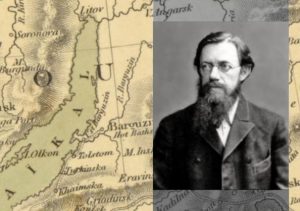 He is one of the most famous Polish explorers of Siberia in Russia. The highest (2,588 m) peak of the Baikal Mountains, one of the peaks (2,090 m) of the Chaman-Daban Mountains, the peak of the Przhymorsky Mountains (728.4 m), the valley of the Kandat River at the foot of the Sayan Mountains, as well as areas near Irkutsk ( where settlements of primitive people were discovered and explored) – all these were named after him. Chersky’s name was also given to a town on the Kolyma River. There are streets named after him in Moscow, Irkutsk, Zhirianka and in the Kolymskoye settlement in the Magadan region. Two mountain ranges called the Chersky Mountains are located in the area of the town of Chita in the Zabaikal region and in northern Yakutia.
He is one of the most famous Polish explorers of Siberia in Russia. The highest (2,588 m) peak of the Baikal Mountains, one of the peaks (2,090 m) of the Chaman-Daban Mountains, the peak of the Przhymorsky Mountains (728.4 m), the valley of the Kandat River at the foot of the Sayan Mountains, as well as areas near Irkutsk ( where settlements of primitive people were discovered and explored) – all these were named after him. Chersky’s name was also given to a town on the Kolyma River. There are streets named after him in Moscow, Irkutsk, Zhirianka and in the Kolymskoye settlement in the Magadan region. Two mountain ranges called the Chersky Mountains are located in the area of the town of Chita in the Zabaikal region and in northern Yakutia.
He was sent to Siberia as punishment because, being a young man, he took part in the January Uprising. He was conscripted by the tsarist authorities into a line battalion in Omsk. While there, he would read a lot of scientific books, study, as well as conduct field research and collect natural specimens. After a few years, he met other exile-researchers: Aleksander Czekanowski, who facilitated his studies in geology and palaeontology, and Benedykt Dybowski. Between 1871 and 1883, at the behest of the Russian Geographical Society, Czerski made many field expeditions. The most important of his activities was a geological survey of the entire shore of Lake Baikal. At the same time, he collected specimens of minerals and fossil fauna. He also developed a geological map of the Baikal coast. In 1877-1881, during four scientific expeditions, he explored the Selenga River valley and wrote a work on Lake Baikal, describing the lake’s genesis and presenting the geological structure of eastern Siberia. For this work he was awarded the gold medal of the Russian Academy of Sciences.
He died on 7 July (25 June according to the Julian calendar) 1892 on the Siberian river Kolyma.
Photo: Public Domain



